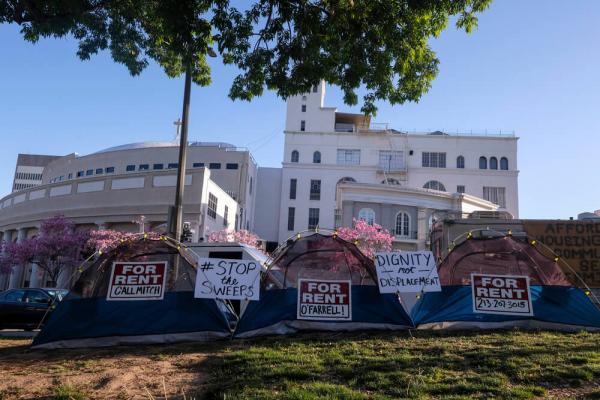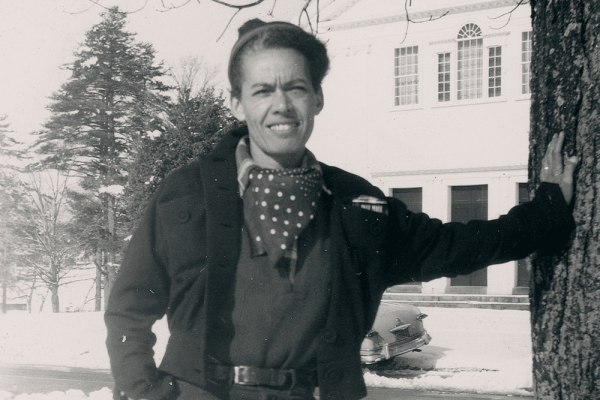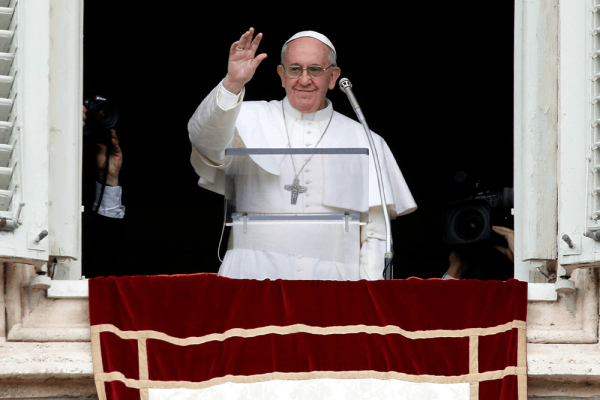Over the past year, unhoused people have experienced unprecedented challenges. Despite this, cities across the United States have stepped up efforts to penalize people experiencing homelessness. In March, hundreds of police officers in Los Angeles kettled and assaulted protesters at Echo Park Lake in order to force out an encampment of unhoused people who had been living in the park. The Echo Park Lake encampment had become a place that included a community kitchen and showers built by residents. Many of the more than 100 people who had been living at the park voluntarily left in advance of the raid.
City officials said the removal of the encampment was necessary to allow for repairs in the park. The park was closed to the public for two months and city officials claimed those living at Echo Park had been rehoused. Los Angeles Mayor Eric Garcetti, described it as “the largest housing transition of an encampment ever in the city’s history.” But in reality, some of the people forced out of the park were left with offers of shelter that never materialized or the shelter that was provided did not meet the individual’s needs.
The raid at Echo Park Lake made national news, but this sort of destruction happens regularly on a smaller scale at encampments all across the country. In Los Angeles, I organize with the group West Valley Homes Yes. West Valley Homes Yes has established relationships with many local unhoused people through weekly outreaches where we provide food and survival supplies. We have seen firsthand the harm caused by criminalizing homelessness and sweeping encampments. Los Angeles implemented a temporary ban on sweeping encampments during the pandemic, so city officials use special enforcement zones around shelters to bypass it. The area around any new shelter or “bridge housing” is part of such a zone. The city Department of Sanitation, often accompanied by police, sweeps such zones every week. This forces people to move from the zone or risk the destruction or confiscation of their shelters, tents, and belongings.
Unhoused people often construct their shelters with care. Many keep pets and have devotional items, artwork, trinkets of personal significance like photos of family members, and plants or small gardens in their homes. Some encampments have dedicated chapels for prayer. In these communities, sweeps not only destroy unhoused people’s belongings but their communities as well. Homes need not be permanent structures to be sacred.
The Bible is full of sacred temporary spaces. When the Israelites came out of Egypt, God’s presence dwelled in the tabernacle which was a makeshift tent (Exodus 35). The prophet Jeremiah told the people not to rely upon the sacredness of “the temple of the Lord” in Jerusalem (Jeremiah 7:4), which was destined for destruction. Instead, Jeremiah said to build houses and plant gardens in the place where they found themselves in exile (Jeremiah 29:5). In Judaism, the importance of the Israelites’ tent-dwelling period is remembered in the festival of Sukkot. This festival, also known as the Feast of Tabernacles, is a harvest festival that commemorates the time when the Israelites wandered in the wilderness after the exodus from Egypt. Some in the Jewish community connect this festival to justice for those experiencing homelessness.
Whether you’re using bricks or canvas, on your own property or on a sidewalk, the making of a home is a sacred act.
Making a home — even a temporary or transient one — is a sacred act because it exemplifies the creative passion that both humans and God share. Theologian Timothy Gorringe in his book A Theology of the Built Environment, describes the human act of building homes, cities, and communities as a reflection of God’s act of creation, reconciliation, and redemption of the material world. Humans should align themselves with these divine desires when building homes, cities, and communities. To do so would reflect God the Creator’s desire for greater justice in our cities.
As people create homes wherever they dwell, they participate in God’s creativity. As they build community with the people around them, they participate in God’s act of reconciliation. And as activists and people of faith, we can participate in God’s act of redemption, too, by standing in solidarity with people experiencing homelessness.
img_4915.jpg

A compassionate, imaginative response to homelessness would respect people’s temporary dwelling places while working toward providing permanent housing for all.
Such a response recognizes the sacredness of people experiencing homelessness as well as their dwelling places. Rather than treating them as “homeless people,” we must see them as equals and collaborate with them to help them obtain permanent housing.
Instead, cities’ responses to homelessness are generally driven by a framework of criminalization and control. Shelter is offered with strict curfews and conditions that require residents to abandon their belongings and leave the people and places they know and the communities they’ve formed on the street. At “bridge housing” sites and other shelters in Los Angeles, residents can only bring a limited number of belongings, usually what fits in two bags. The disregard for people’s belongings and attachments is a desecration of the homes and communities unhoused people have built.
Creating sacred space, whether in temporary dwellings or permanent homes, is ultimately about constructing community. Community creates safety through mutual care for one another. Often, the political response to unhoused people is instead based on the contrived premise that they are a danger to neighborhoods. People experiencing homelessness are offered shelter only if they place themselves in prison-like conditions where they are required to forfeit their rights to come and go as they please and to have keys to their own “homes.” Cities and service providers force unhoused people to abide by strict conditions because of the false belief that they are a threat to community “safety and security.”
Prison abolitionist Mariame Kaba provides a helpful distinction between “safety” and “security”: Security is what we try to impose by controlling other people; safety is what we build by establishing relationships of mutual care. Safety arises in the sacred spaces of our homes and communities — including when we work with people experiencing homelessness. Security, on the other hand, is a form of violence that puts us in conflict, pitting the rich against the poor and those who have houses against those who do not. Safety is an outgrowth of mutual care that recognizes the sacredness of the homes and communities of all people, even if those homes and communities are transient.
Jesus tells us to see him among those who do not have shelter (Matthew 25:31–46). Our obligation to those experiencing homelessness is to offer them permanent housing and to do so in a way that collaborates with them as equal partners and values the communities they have already built (Isaiah 58:7). Christians are called to recognize Jesus as the creator and author of every community who not only appears in the face of those experiencing homelessness, but in their communal dwelling spaces as well — no matter how temporary or transient. Our respect for divine creativity should guide our efforts to work toward mutual care, true safety, and reconciled communities.
Got something to say about what you're reading? We value your feedback!







